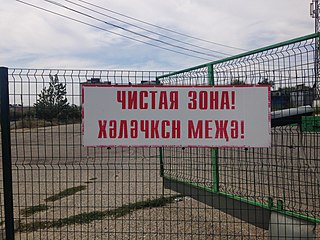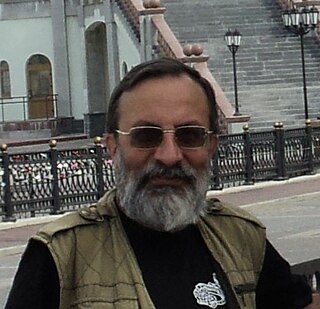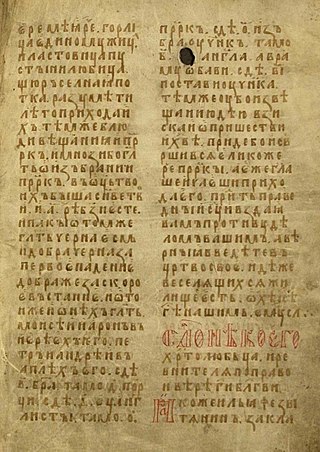Related Research Articles

The Baltic languages are a branch of the Indo-European language family spoken natively or as a second language by a population of about 6.5–7.0 million people mainly in areas extending east and southeast of the Baltic Sea in Europe. Together with the Slavic languages, they form the Balto-Slavic branch of the Indo-European family.

Kalmyk Oirat, commonly known as the Kalmyk language, is a variety of the Oirat language, natively spoken by the Kalmyk people of Kalmykia, a federal subject of Russia. In Russia, it is the standard form of the Oirat language, which belongs to the Mongolic language family. The Kalmyk people of the Northwest Caspian Sea of Russia claim descent from the Oirats from Eurasia, who have also historically settled in Mongolia and Northwest China. According to UNESCO, the language is "Definitely endangered". According to the Russian census of 2021, there are 110,000 speakers of an ethnic population consisting of 178,000 people.

Mat is the term for vulgar, obscene, or profane language in Russian and some other Slavic language communities.

The Finno-Samic languages are a hypothetical subgroup of the Uralic family, and are made up of 22 languages classified into either the Sami languages, which are spoken by the Sami people who inhabit the Sápmi region of northern Fennoscandia, or Finnic languages, which include the major languages Finnish and Estonian. The grouping is not universally recognized as valid.

The Finnic or Baltic Finnic languages constitute a branch of the Uralic language family spoken around the Baltic Sea by the Baltic Finnic peoples. There are around 7 million speakers, who live mainly in Finland and Estonia.
The birch bark letter given the document number 292 is the oldest known document in any Finnic language. The document is dated to the beginning of the 13th century. It was found in 1957 by a Soviet expedition led by Artemiy Artsikhovsky in the Nerevsky excavation on the left coast side of Novgorod. It is currently held at the Novgorod City Museum.

Jovan Ajduković is a Serbian linguist.
Oleg Nikolayevich Trubachyov was a Russian linguist. A researcher of the etymology of Slavic languages and Slavic onomastics, he was considered a specialist in historical linguistics and lexicography. He was a Doctor of Sciences in Philological Sciences, an academician of the Russian Academy of Sciences and served as the editor-in-chief of the Etimologiya yearbook. His works are on the etymology of Slavic languages and on East Slavic onomastics.

The Etymological Dictionary of Slavic Languages: Proto-Slavic Lexical Stock is an etymological dictionary of the reconstructed Proto-Slavic lexicon. It has been continuously published since 1974 until present, in 43 volumes, making it one of the most comprehensive in the world.
While many Slavic languages officially use Latin-derived names for the months of the year in the Gregorian calendar, there is also a set of older names for the twelve months that differs from the Latin month names, as they are of Slavic origin. In some languages, such as the Serbian language these traditional names have since been archaized and are thus seldom used.

Merílo Právednoye or Just Measure is a Russian collection of writings from the late 13th or early 14th century, preserved in the copies of the 14th to the 16th centuries. The name was given in modern literature, taken from the first words of this text: "this books is just measure, true weighing...". Just Measure was written in Church Slavonic and Old Russian.

Vladimir Petrukhin is a Russian historian, archaeologist and ethnographer, Doctor of Historical Sciences, chief research fellow of the Medieval Section in the Institute of Slavic Studies in the Russian Academy of Sciences, professor of Higher School of Economics.
Albina Khakimovna Girfanova, was a Russian linguist and anthropologist. She worked at the Institute for Linguistic Studies, Russian Academy of Sciences, and later at Saint Petersburg State University, where she attained the rank of Docent. Girfanova is most known for her work on Udege and Oroch languages, as well as on a number of other Tungusic languages and Balkan languages. She is the author of the most significant vocabulary of Udege, published in Russia, as well as other important studies and reference sources of Udege, Oroch and Balkan languages.
Tyurya, sometimes known as murtsovka, is a traditional bread soup in the Russian cuisine, sometimes considered a variant of okroshka. It consists of chunks of bread, often stale or semi-stale, or dried/baked into sukhari biscuits/hardtack, soaked in a flavorful liquid or, alternatively, plain water, with some vegetables and vegetable oil added and flavored with salt and pepper. The base liquid could be anything that can be consumed cold, because unlike most other bread soups, tyurya was prepared and consumed without heat. Kvass was historically the most popular base for tyurya, due to it being cheap, plentiful and flavorful enough. A dairy base, like plain or sour milk, whey or kefir was considered fancy and was generally prepared for children, the elderly or the infirm. It is, along with pokhlyobka, a traditional Lenten soup.
Nikolai Zolotnitsky was a Russian Chuvash linguist and one of the founders of national Chuvash scientific linguistics. He was also a comparative Turkologist, ethnographer, teacher, and public figure.

Pseudo-mythology are myths and deities which do not exist in genuine mythology and folklore or their existence is doubtful or disproved. It may be created by researchers who liberally interpret scarce sources.

The Word of a certain Christ-lover and zealot for the right faith is a significant work of ecclesiastical Old East Slavic literature. It is an Orthodox work directed against folk customs and pagan beliefs and rituals.
Siberian dialects are a group of Northern Russian dialects under the serious lexical influence of the Southern Russian dialects and foreign inclusions. It is spoken by Siberian old-timers: Siberiaks, Chaldons, Kerzhaks, Cossacks, Old Believers, Pokhodchans (Kolymchans), Russian Ustians (Indigirshchiks), and Markovites (Anadyrshchiks).

The Aukh dialect is a dialect of the Chechen language. It is primarily spoken by residents in the northern part of Dagestan, and the estimated number of speakers is about 160 thousand.
References
- ↑ "Skoliniai" [loanwords]
- ↑ Marta Rudzīte, Latviešu un lībiešu valodas savstarpējā ietekme
- ↑ "Материалы для словаря древнерусского языка по письменным памятникам. Том 1. А-К : И.И.Срезневский". archive.org. 1893. Retrieved 2023-06-03.
- ↑ Шилов, А.Л. Чудские мотивы в древнерусской топонимии / А. Л. Шилов. - Москва : Изд. группа "Реформ-пресс", 1996. - 95 с.; 21 см.; ISBN 5-88971-006-0
- ↑ Kostomarov, V. G. (2020-03-22). "БЕЗ РУССКОГО ЯЗЫКА У НАС НЕТ БУДУЩЕГО" (PDF). РУССКИМ ЯЗЫК В СОВРЕМЕННОМ МИРЕ. Retrieved 2023-06-03.
- ↑ Л. П. Михайлова, ПРИБАЛТИЙСКО-ФИНСКИЙ КОМПОНЕНТ В РУССКОМ СЛОВЕ, In: Русская и сопоставительная филология: состояние и перспективы. - Казань, 2004, pp. 148-149
- ↑ Uralic and Altaic Series, Vol. 90, 1968, pp. 72, 95 (snippets)
- ↑ Janine A.E. Strandberg, Charlotte Gooskens, Anja Schüppert, Errors or identity markers? A survey study on the use of and attitudes towards finlandisms and fennicisms in Finland Swedish